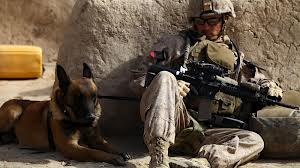My post today is on a more serious topic than my usual attempts at humor. A few weeks ago I was planning future blog topics and an obvious choice was to write about holidays. Halloween and Thanksgiving are pretty straightforward, but I thought I’d tackle Veteran’s Day too. I searched online for information about dogs that have served in the U.S. military.
As long as humans have fought wars, dogs have served. Their duties varied from acting as sentries to intimidating prisoners and sniffing out explosive devices. The modern military dog is equipped with a canine tactical vest with cameras and microphones so the handler can assess a situation remotely.
I learned that as many as 5,000 dogs served during the Vietnam War, supporting about 10,000 handlers. They worked primarily as sentries and scouts. Sadly, military dogs were officially classified as “equipment,” and when the U.S. left Vietnam in 1973, a lot of “equipment,” including over 200 military dogs, were left behind. “Equipment” remains a highly charged word in the military dog handler community.
I also learned about post-traumatic stress disorder, or PTSD. Approximately 20% of returning soldiers are affected by it, and dogs are uniquely qualified to help. How? On the surface, dogs don’t judge. We remind veterans of the joy of simple things, like a belly rub. We’re cute, we’re cuddly, and we love our people unconditionally.
Dogs with more training can learn to perform helpful tasks and comfort veterans when they experience symptoms such as an anxiety attack. Canine service programs for veterans have been so successful that there is a growing number of organizations, such as Soldier’s Best Friend in Glendale, Arizona, that connect veterans diagnosed with PTSD or Traumatic Brain Injury with a service dog.
Does it work? According to Vanessa Woods of Duke University, “Initial studies by the Psychiatric Service Dog Society found that 82 percent of dog handlers with PTSD reported a decline in symptoms after working with the canines. Dogs can be trained to do a variety of tasks, including safety-checking a room, reminding their owners to take their medication — and if the owner is having nightmares, their dog can even turn on the lights and wake them up.

Clearly, we are very sensitive, from our noses to our hearts. So how do we fare in combat? The Los Angeles Times published an article on November 26, 2012, stating that about 10 percent of dogs that serve in combat develop Canine PTSD. That’s roughly 250 of the estimated 2,500 dogs that were serving this time last year. They become afraid of loud noises, will refuse to enter certain vehicles or buildings, and exhibit other signs of anxiety and fear. Hmm.
Obviously there is value in having dogs assist in combat, but at what cost? Is our value in combat zones equivalent to our value at home, assisting veterans in their recovery? Humans may not be able to cure PTSD (or, apparently, even provide comfort), but they can invent all sorts of sensing devices and robots and drones. We dogs are pretty awesome, especially our strong sense of smell. But surely humans who are capable of building such a vast repertoire of weapons can also create machines that mimic our abilities to sniff them out. . . .Right?
Thank you to all the veterans—human and canine—who have served our country.
Woof!
Scruffy

